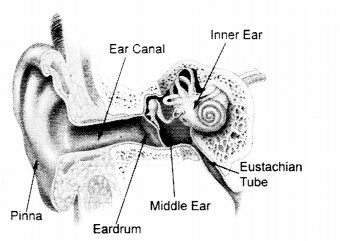Rajasthan Board Solutions for Class 8 Science Chapter 10 Sound
| Board | RBSE |
| Class | Class 8 |
| Subject | Science |
| Chapter | Chapter 10 |
| Chapter Name | Sound |
| Number of Questions Solved | 48 |
| Category | RBSE Solutions |
Sound Textbook Questions Solved
I. Multiple Choice Questions
Question 1.
- In which medium, the transmission of sound is not possible?
(a) Iron rod
(b) Water
(c) Air
(d) Vacuum - The up-down motion around the mean position of an object is called
(a) Vibration
(b) Amplitude
(c) Frequency
(d) Periodic time - Speed of sound at 0°C in air is
(a) 350 m/sec
(b) 200 m/sec
(c) 400 m/sec
(d) 331 m/sec - Time taken to complete one vibration is called-
(a) frequency
(b) time period
(c) amplitude
(d) none of these
Answers:
- (d)
- (a)
- (d)
- (b)
Question 2.
In the following statements, tick (T) against those which are true, and (F) against those which are false:
- Sound generate due to vibration in objects. (True/False)
- The sound waves do not need medium to transmission. (True/False)
- The sound has maximum velocity in solids. (True/False)
- The unit of loudness of sound is decibel (db) (True/False)
Answers:
- True
- False
- True
- True.
Question 3.
Fill in the blanks.
- Main source of sound in human is …………………
- The sound waves having frequency more than 20,000 hertz are called …………………
- The international unit of frequency is …………………
- The loudness of sound depends on …………………
- The pitch of sound depends on …………………..
Answer:
- Larynx
- Ultrasonic Sound
- Hertz
- Amplitude of vibration
- Frequency
Sound Short Answer Type Questions
Question 1.
A musical instrument takes 2 seconds to complete 200 oscillations then calculate frequency of it.
Answer:
Question 2.
The ringing bell in a temple has frequency 400 vibration/sec, then calculate the periodic time of it.
Answer:

Question 3.
What are differences in audible, infra-audible, ultra-audible.
Answer:
If the frequency of the vibrations is less than 20 Hz, then the human ear cannot perceive them. Such vibrations are called infrasonic vibrations. If the frequency of vibrations is between 20 Hz to 20,000 Hz, then they can be perceived by the human ear. Such vibrations are called sonic vibrations or sound vibrations. It has been further found that higher the frequency, the sharper or shriller is the effect of sound on the ears. However, if the frequency of vibrations is above 20000 Hz, then the human ear cannot perceive them. Such vibrations are called ultrasonic vibrations or ultrasonics.
Question 4.
Define frequency and periodic time. Represent the relation of them by a formula.
Answer:
Frequency: The number of vibrations or oscillations per second is called frequency.
Time period: Time required to complete one oscillation or vibration is called time period.
Following is the relationship between frequency and time period.![]()
Sound Long Answer Type Questions
Question 1.
Draw an human vocal system diagram and explain its working principle.
Answer:
The sound is produced by the voice of sound box or the larynx in human. It is located in the throat. Below to it is the wind pipe. The two vocal cords, are stretched across the voice box or larynx in such a way that it leaves a narrow slit between them for the passage of air. When the lungs force air through the slit, the vocal cords vibrate and the vibration results in sound.
Question 2.
What is noise pollution? How does it affect us? How can it controlled? Explain it in detail.
Answer:
The disturbance (irregular sound waves) produced in the environment by the undesirable, loud and harsh sound from the various sources is called noise pollution.
Noise pollution is a recent phenomenon of the twentieth century. Increasing dependence of the man on various kinds of machines at home, at work place in factories etc., has contributed a lot to the noise pollution.
The noise pollution at a particular place is determined by following:
(a) Loudness of the sound
(b) Duration of noise at a particular place.
Harmful effects:
- Noise in the surroundings interferes with speech and talk with another person.
- A long exposure to noise pollution may result in the loss of hearing to deafness.
- Noise pollution reduces concentration and results in the loss of work efficiency.
- Noise causes anger, tension and interferes with the sleep pattern of the individuals,
- Noise produces headaches, irritability and nervous tension.
- Noise can cause loss of night vision as well as cause colour blindness.
Preventive and control of noise:
In the modern society we can not eliminate noise, but can lower its level to bearable limits by taking following measures:
- The machines should be desinged in such a way that they produce minimum noise.
- All automobiles, electric generators etc, should be provided with improved silencers.
- The heavy vehicles should not be allowed in residential areas.
- The use of loudspeakers for various social or religious functions should be banned.
- The factories should be relocated far away from the residential areas.
- At homes, the T.V, the radio, the power music system etc. should be played at low volume.
Question 3.
Explain the process of receiving the sound signals to brain with labelled diagram of human ear.
Answer:
Outer ear receives the vibrations and transmits them to the ear canal. The canal carries the vibration that stricke a stretched membrane called the ear drum. From the ear drum the vibration passes to the middle ear. Middle ear has three delicate bones-hammer, anvil and stirrup. These bones pass on the vibrations to the inner ear. Inner ear: It has a coiled tube called the cochlea. Tiny hairs in this liquid filled tube pick up vibrations from the middle ear. They send a signal to the brain through the auditory nerve and we hear the sound.
Question 4.
How is sound transmitted in solid and gases? Explain it.
Answer:
Sound travels through different medium:
(a) Sound transmission in gas:
Sound travels through air from its place of origin and reaches to our ears. In air it travels through vibration, when object vibrates, then atoms of air also vibrates, every vibrated atom transfer propagates this vibration to next atoms. In this way a wave of sound reaches to our ear where it strikes with the ear drum, and it starts vibrating and we listen sound.
(b) Sound transmission in solid:
Take lm scale, 2 cm long metal wire and 2 m long thread, keep one end of the scale on owner and ask your friend to create sound by light rubbing of other end of scale with nails. Repeat the same by stretching and rubbing metal wire and thread. The vibrations produced at first end reaches to the other end. Hence, it is clear that sound also travels through solids. In labs when turning forks are vibrated and brought near to the ear, sound is heard.
Sound Additional Questions Solved
I. Multiple Choice Questions
Question 1.
Sound cannot travel through:
(a) Air
(b) Water
(c) Iron
(d) Vaccum
Question 2.
Speed of sound is least in:
(a) Solid
(b) Liquid
(c) Gas (air)
(d) None of these
Question 3.
The number of virbration/oscillation executed per second is known as:
(a) Frequency
(b) Amplitude
(c) Wave length
(d) Pitch
Question 4.
The S.I unit of frequency is in
(a) m/s
(b) Hertz
(c) Per second
(d) None of these
Question 5.
Loudness of sound depends upon-
(a) Wave length
(b) Speed of sound
(c) Amplitude
(d) None of these
Question 6.
The sound of frequency less than 20 Hertz is known as
(a) Ultra sonic
(b) Infra sonic
(c) Sonic
(d) None of thesehttps
Question 7.
Low sound such as normal breathing has loudness upto
(a) 5 decibel
(b) 20-30 decibel
(c) 10 decibel
(d) 50-60 decibel
Question 8.
The sound in the audible range is called-
(a) Ultra sonic
(b) Sonic
(c) Sub sonic
(d) Light sound
Question 9.
Eardrum is a part of
(a) Hearing organ
(b) Sound producing organ
(c) Muscular system
(d) None of these
Question 10.
The pitch of sound depends upon the
(a) amplitude
(b) wave velocity
(c) wave length
(d) frequency
Question 11 .
The outer part of human ear is called
(a) Pinna
(b) Ear drum
(c) Tympanum
(d) None of these
Question 12.
The sound used in sonography is
(a) Infrasonic
(b) Audiable
(c) Ultrasonic
(d) None of these
Question 13.
Relation between frequency and time period is-
(a) Time period = frequency
(b) (Frequency)2 = time period
Question 14.
The voice box is also known as
(a) Mouth
(b) Larynx
(c) Heart
(d) Stomach
Question 15.
A pendulum oscillates 20 times in 2 seconds then its time period is
(a) 0 .01 sec
(b) 0.001 sec
(c) 0 .02 sec
(d) 0.1 sec
Answers:
1. (d)
2. (c)
3. (a)
4. (b)
5. (C)
6. (b)
7. (c)
8. (b)
9. (a)
10. (d)
11. (a)
12. (c)
13. (c)
14. (b)
15. (d)
Sound Very Short Answer Type Questions
Question 1.
What is sound?
Answer:
Sound is a form of energy which usually produces the sensation of hearing in our ears.
Question 2.
What is the most common medium through which sound travels?
Answer:
Air is the most common medium through which sound travel.
Question 3.
Can sound propagate through vacuum?
Answer:
No, its need material medium for its propagation.
Question 4.
What is time period? Write its S.I unit.
Answer:
The time taken by one complete oscillation in the density of the medium is called time period. It is denoted by the capital letter T. Its S.I unit is second.
Question 5.
What is frequency? How is it represented? Write its S.I unit.
Answer:
The number of vibration/oscillation per second is called the frequency of the wave. It is represented by the symbol v (nu). Its S.I unit is Hertz (Hz).
Question 6.
What do you mean by the term loudness?
Answer:
The sound of high amplitude is called loudness.
Question 7.
What is amplitude?
Answer:
The maximum displacement of the vibrating object about its mean position is called amplitude.
Question 8.
What type of sound waves does a bat, rat, and whale produced?
Answer:
Ultra sound.
Question 9.
Write the full form of SONAR?
Answer:
SONAR- Sound Navigation and Ranging.
Question 10.
What is the frequency of a wave whose time period is 0.05 second?
Answer:
Frequency is defined as the wave passing through a point in second.
Question 11.
Give three medical uses of ultrasound.
Answer:
- Use to break the stone in kidney into fine grains.
- Use to investigate the internal organ of human body.
- Used to monitor the development of unborn baby inside the mother’s uterus.
Question 12.
What is embryo death?
Answer:
Few people are identifying the sex of a child, during pregnancy and they found that the infant child is girl and make abortion, this is called embryo death.
Question 13.
What is audible sound range?
Answer:
The sound having frequency 20 Hz to 20000 Hz can be heard by us is called
audible sound.
Question 14.
Can SONAR technique can be used to determine the depth of the sea?
Answer:
Yes, SONAR technique can be used to determine the depth of the sea.
Question 15.
How do we feel sound?
Answer:
Sound produces vibration in eardrum. It send to brain through ear cavity by which we feel sound.
Sound Short Answer Type Questions
Question 1.
The pulse rate of a man is 80 beats in one minute. Calculate its frequency.
Answer:
Pulse rate of man is 80 beats in one minute.
No. of beats = No. of vibrations = 80 Time period = 1 minute = 60 sec
∴ Frequency = [latex]\frac { 80 }{ 60 }[/latex] =1.33 Hz
Question 2.
Explain loudness or intensity of sound.
Answer:
Loudness is the characteristic of a sound which distingushes a feeble sound from a loud sound of the some frequency. When the amplitude of a vibrating body increases loudness increases. We can also say that when surface area of the vibrating bodies increases loudness increases.
Question 3.
Derive a relationship between the time period and frequency of a wave.
Answer:
The time required to complete one wave is equal to the time period (T) of the wave.
Thus, Number of wave produced in T seconds = 1
then, number of wave produced in 1 sec = [latex]\frac { 1 }{ T }[/latex]
But as per definition, the number of waves produced in one second is equal to the frequency (V). Therefore,
Question 4.
Distinguish between musical sound and Noise.
Answer:
The difference between musical sound and noise are:
| Musical Sound | Noise |
| (i) It is pleasant to hear. | (i) Jarring and unpleasant to hear. |
| (ii) The pitch and loudness do not change suddenly. | (ii) The pitch and loudness change very much. |
| (iii) The sound is repeated periodically. | (iii) There is no periodic repetitions of frequency. |
Question 5.
What is noise pollution. How can we control noise pollution?
Answer:
As we know that the unpleasant sounds are called noise. High pitched noise is usually more annoying than low pitched noise. Noise can damage the ears, cause of tiredness and loss of concentration. If it is very loud, it may even result in sickness and temporary deafness. Some commonly heard noise are those made by flying air craft, moving vehicles, greatly amplified music, and machinery including domestic appliances.
Such unwanted noise can be reduced by:
- Fitting vehicles with silencers.
- Using sound insulating material at home such as carpets, curtains, planting trees between houses and roads.
- Wearing ear protectors which minimise noise effects.
Sound Long Answer Type Questions
Question 1.
Differentiate between Loundness and Pitch.
Answer:
The following are the differences between loundness and pitch:
| Loudness | Pitch |
| (i) Loudness depends upon the extent of amplitude of the vibrating body. | (i) Pitch is the effect produced in the brain by the sound of some particular frequency. |
| (ii) Loudness of sound is determined by the amount of energy received by the ear in unit time, i.e. the more the energy received, the louder is the sound. | (ii) Pitch does not depend upon the amount of energy received by the ear. |
| (iii) Loudness does not change with the change in frequency. | (iii) Pitch changes with the change in frequency. As a rule, a lower frequency will produce a bass sound, whereas a higher frequency will produce a shrill sound. |
Question 2.
Which object is vibrating when the following sounds are produced?
(a) The sound of a sitar or veena.
(b) The sound of the tabla.
(c) The sound of a school bell
(d) The buzzing of bee or a mosquito.
(e) The sound of a bursting balloon
(f) The radio.
Answer:
(a) Strings of sitar or veena vibrate to produce sound.
(b) The skin of the tabla vibrate to produce sound.
(c) The disc of the bell when beated with hammer vibrate to produce sound.
(d) Wings of the mosquito or a bee vibrate to produce sound.
(e) Air vibrates to produce sound.
(f) In the radio speakers vibrate to produce sound.








